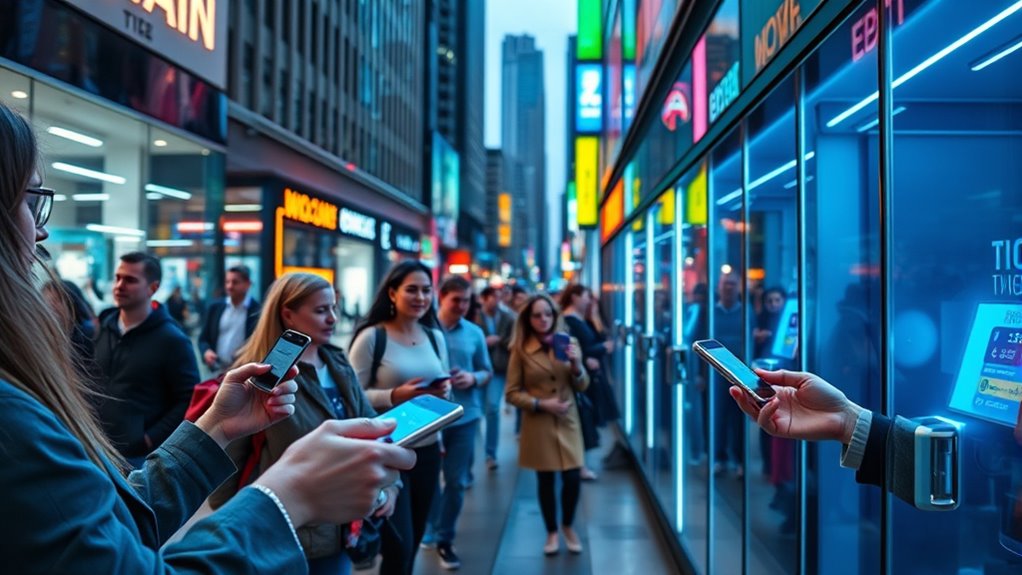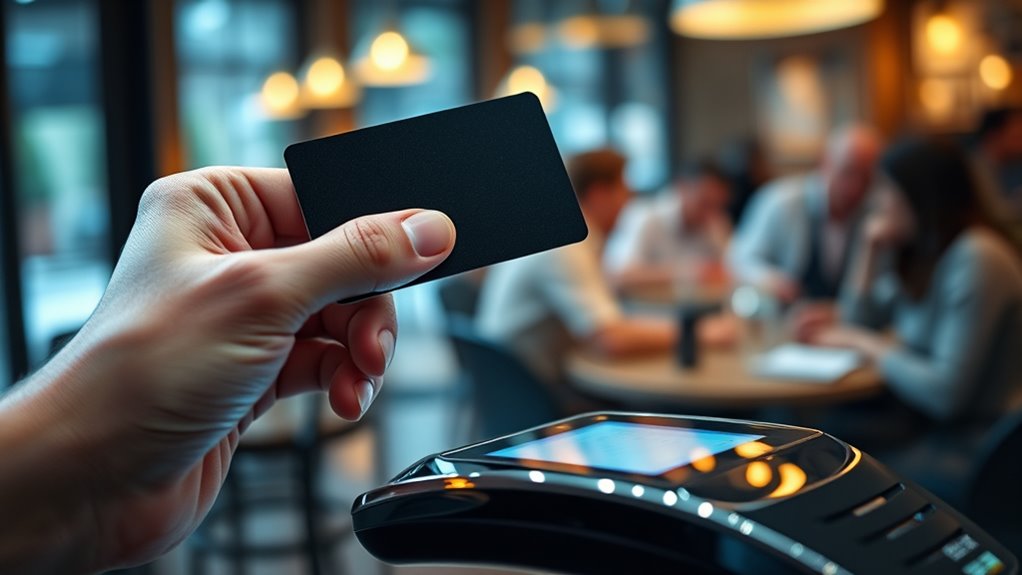By 2025, contactless payments are set to dominate your everyday transactions as adoption soars worldwide. More consumers, especially Millennials and Gen Z, prefer tap-to-pay for its speed, convenience, and security. Businesses are rapidly embracing NFC and digital wallets, making checkout faster and safer. With innovative biometric authentication and the exponential growth in mobile wallets, contactless will become the norm. Stay tuned to discover how this shift can transform your payment experience.
Key Takeaways
- Market projections show contactless payments surpassing $10 trillion by 2027, driving widespread adoption by 2025.
- Over 82% of consumers globally already use contactless methods, indicating rapid acceptance.
- Millennials and Gen Z are leading adoption, favoring digital wallets for everyday transactions.
- Contactless transactions are faster, more secure, and increasingly integrated into POS systems worldwide.
- Regional adoption, especially in Asia Pacific, and advancements in biometric security support universal tap-to-pay.

By 2025, tap-to-pay technology will be everywhere you go, transforming how you shop, commute, and pay. The contactless payment industry is projected to hit $164.15 billion by 2030, growing at a compound annual rate of 19.1%. Meanwhile, market estimates suggest it’ll expand from $22.4 billion in 2022 to over $90.6 billion by 2032, with a steady 15.4% CAGR. Digital transactions are expected to account for 67% of all payments by 2025, a significant jump from 57% before the pandemic. Over 4.4 billion people worldwide are forecasted to use digital wallets by then, reflecting how deeply embedded contactless payments are becoming. In fact, contactless payments are predicted to surpass $10 trillion by 2027, with a staggering 221% growth between 2022 and 2026.
By 2025, digital payments will dominate, with over 4.4 billion users and industry growth surpassing $164 billion.
You’ll notice more and more merchants adopting tap-to-pay options. In the U.S., more than half of smartphone users—around 125 million people—will regularly use proximity mobile payments by 2025. Globally, 82% of consumers already use contactless methods, up from 74% in 2022. Millennials and Gen Z are leading the charge, with 73% and 66% respectively making contactless payments frequently. The convenience factor is clear; over 70% of people prefer digital wallets as their primary shopping method, and 62% would use them for travel. In the UK, nearly all debit card transactions under £100 were contactless in 2023, highlighting how common this payment method has become. The rise of contactless payments has also led to increased consumer confidence in digital security, encouraging even more widespread adoption. Transaction volumes reflect this rapid shift. In 2023, global contactless transactions exceeded $17 trillion, increasing 25% year-over-year. Contactless payments now make up 45% of all card transactions worldwide, up from 30% in 2020. In the U.S., mobile wallet transactions jumped 32% to $1.9 trillion in 2023. What’s more, contactless payments are incredibly fast—taking only 1 to 2 seconds, roughly 60% quicker than chip payments. The average transaction value has also increased, reaching about $85 in 2023, compared to $70 in 2021.
For merchants and businesses, the benefits are undeniable. Nearly 78% of small businesses in the U.S. that adopted contactless payments reported increased sales and happier customers. Retailers experienced a 20% boost in checkout speed after installing contactless POS systems. Offering mobile wallets often results in a 12% higher transaction value on average. Over 60% of independent retailers invested in NFC-compatible POS terminals in 2023, recognizing the importance of staying current. Contactless payments also help reduce fraud; businesses that use tokenization saw a 35% drop in fraudulent cases.
Regionally, Asia Pacific led the global adoption, with over $1.5 trillion in transactions by 2020. Younger consumers—millennials and Gen Z—are driving most of this growth, especially in retail and transit sectors, where convenience reigns supreme. As smartphones and smartwatches become primary access points, contactless payments are set to become the norm, fundamentally changing how you pay in everyday life. [This widespread adoption is further supported by advancements in biometric authentication, which enhance security and user confidence in contactless transactions.
Frequently Asked Questions
Will All Countries Adopt Tap-To-Pay by 2025?
You might wonder if all countries will adopt tap-to-pay by 2025. Given current trends, many regions like China, Europe, and Australia are rapidly embracing contactless payments, driven by convenience, technology, and infrastructure. However, adoption varies due to factors like economic development, digital infrastructure, and government support. While many nations will move toward widespread tap-to-pay, some may lag behind due to these differences, making universal adoption by 2025 unlikely.
How Secure Is Tap-To-Pay Compared to Traditional Cards?
Think of tap-to-pay as a fortress built with dynamic cryptographic shields. Compared to traditional cards, it’s more secure because it uses tokens and encryption, making your data less vulnerable. Near-field communication limits interception, and biometric authentication adds extra layers of protection. While some worry about risks, these innovations markedly reduce fraud, making tap-to-pay a safer choice than magnetic stripe cards, which are more exposed to cloning and skimming.
What Devices Will Support Tap-To-Pay Beyond Smartphones?
You’ll find tap-to-pay supported on a variety of devices beyond smartphones. Smartwatches, fitness trackers, and connected cars now enable quick payments. Retail displays, vending machines, ATMs, and public transit systems are adopting NFC technology too. Future devices like smart home gadgets, healthcare equipment, gaming consoles, and even smart mirrors will incorporate tap-to-pay. This broad device ecosystem makes contactless payments more convenient and integrated into your everyday life.
Will There Be Increased Costs for Merchants to Implement Tap-To-Pay?
You might think tap-to-pay means extra costs, but ironically, it often saves you money. Without needing new hardware, you cut upfront expenses, and newer solutions lower ongoing maintenance. Sure, processing fees might rise a bit, but overall, you’ll likely spend less on hardware, repairs, and management. As technology advances and competition grows, costs will keep dropping, making tap-to-pay not just convenient but increasingly affordable for your business.
How Will Privacy Concerns Be Addressed With Widespread Tap-To-Pay?
You might worry about privacy with widespread tap-to-pay, but security measures are evolving to address those concerns. You’ll see encryption, tokenization, and biometric authentication protect your data, while AI detects suspicious activity in real time. Regulations like PCI DSS and data protection laws also strengthen privacy standards. As a consumer, staying informed about these safeguards helps you trust contactless payments more and enjoy their convenience securely.
Conclusion
By 2025, it’s clear that tap-to-pay isn’t just a trend—it’s becoming the norm. You might wonder if this seamless payment method really will take over entirely, and honestly, it’s likely true. As technology advances and security improves, you’ll find yourself reaching for your phone or watch more often than cash or cards. It’s almost like the universe is nudging us toward a cashless future—so why not embrace it?









